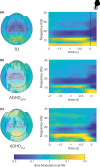Dorsal-to-ventral imbalance in the superior longitudinal fasciculus mediates methylphenidate's effect on beta oscillations in ADHD
- PMID: 35165906
- PMCID: PMC9287074
- DOI: 10.1111/psyp.14008
Dorsal-to-ventral imbalance in the superior longitudinal fasciculus mediates methylphenidate's effect on beta oscillations in ADHD
Abstract
While pharmacological treatment with methylphenidate (MPH) is a first line intervention for ADHD, its mechanisms of action have yet to be elucidated. We here seek to identify the white matter tracts that mediate MPH's effect on beta oscillations. We implemented a double-blind placebo-controlled crossover design, where boys diagnosed with ADHD underwent behavioral and MEG measurements during a spatial attention task while on and off MPH. The results were compared with an age/IQ-matched control group. Estimates of white matter tracts were obtained using diffusion tensor imaging (DTI). Via a stepwise model selection strategy, we identified the fiber tracts (regressors) significantly predicting values of the dependent variables of interest (i.e., oscillatory power, behavioral performance, and clinical symptoms): the anterior thalamic radiation (ATR), the superior longitudinal fasciculus ("parietal endings") (SLFp), and superior longitudinal fasciculus ("temporal endings") (SLFt). ADHD symptoms severity was associated with lower fractional anisotropy (FA) within the ATR. In addition, individuals with relatively higher FA in SLFp compared to SLFt, led to stronger behavioral effects of MPH in the form of faster and more accurate responses. Furthermore, the same parietotemporal FA gradient explained the effects of MPH on beta modulation: subjects with ADHD exhibiting higher FA in SLFp compared to SLFt also displayed greater effects of MPH on beta power during response preparation. Our data suggest that the behavioral deficits and aberrant oscillatory modulations observed in ADHD depend on a possibly detrimental structural connectivity imbalance within the SLF, caused by a diffusivity gradient in favor of parietal rather than temporal, fiber tracts.
Keywords: ADHD; meg; methylphenidate; oscillations.
© 2022 The Authors. Psychophysiology published by Wiley Periodicals LLC on behalf of Society for Psychophysiological Research.
Figures










References
-
- American Psychiatric Association . (2013). Diagnostic and statistical manual of mental disorders (5th ed.) (A. P. Association & A. P. A. D.‐5 T. Force [eds.]). American Psychiatric Association. 10.1176/appi.books.9780890425596 - DOI
-
- Arns, M. , Vollebregt, M. A. , Palmer, D. , Spooner, C. , Gordon, E. , Kohn, M. , Clarke, S. , Elliott, G. R. , & Buitelaar, J. K. (2018). Electroencephalographic biomarkers as predictors of methylphenidate response in attention‐deficit/hyperactivity disorder. European Neuropsychopharmacology, 28(8), 881–891. 10.1016/j.euroneuro.2018.06.002 - DOI - PubMed
Publication types
MeSH terms
Substances
Grants and funding
LinkOut - more resources
Full Text Sources
Medical
Miscellaneous

